We are excited to bring you this Neil Macdonald interview. Our conversation covered some ground but primarily we spoke to Neil about his forthcoming book, Elsewhere, which explores U.K. skateboarding between 1987 and 2002 in some staggering depth, via hundreds of interviews and countless rare and classic photographs…
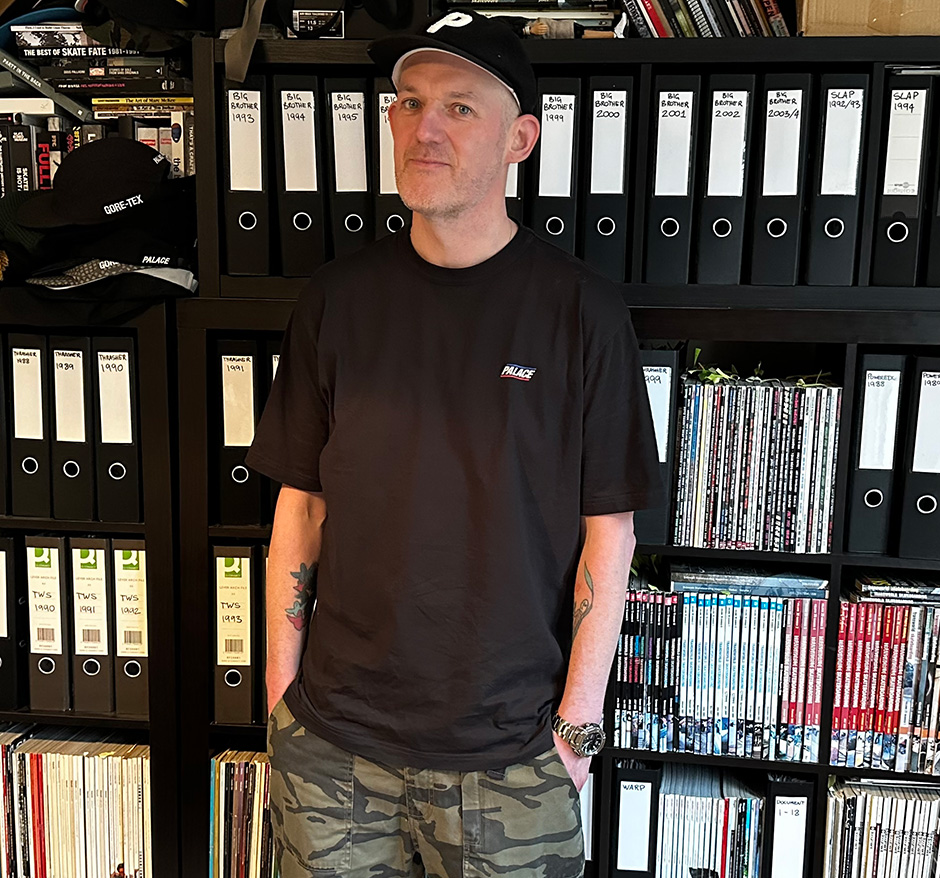
words and interview by Jacob Sawyer. Neil Macdonald and the Science Versus Life archives. PH: Ray Calthorpe
Neil Macdonald is a good friend, to myself, to Slam City Skates, and to skateboarders globally. His excellent @scienceversuslife Instagram account jogs memories, sends us down rabbit holes, and improves our lives on a daily basis. Running this account was born from his desire to share the photographic gold in his extensive magazine collection, inviting us all into a carefully curated virtual reading session, an evolution of our teenage selves sheltering in bedrooms all around this wet island. Maintaining this account is now something Neil does innately, it is routine. However, his routine nowadays involves so much more. He has embarked on a huge project of his own volition.
Elsewhere is the title of a new book that Neil has been busy working on full-time for almost three years already. This is set to be the definitive history of UK skateboarding from 1987-2002, a huge undertaking he is busy making sense of. It is common for books, or documentaries to scratch the surface of their subject matter when the creators are lazy, or lack sufficient access to people who play integral roles in the narrative they are weaving. This couldn’t be further from the truth when it comes to Elsewhere. This labour of love has become Neil’s raison d’être and he is employing no half measures when it comes to compiling content and ensuring no stone is unturned. These days when he isn’t speaking to people at length about their experiences, he is busy transcribing those conversations, and lining up the next one. Through an ever-expanding network he has also been steadily accruing more unseen photos and pieces of ephemera than he ever imagined
Elsewhere will unpack fifteen years that were crucial to the development of UK skateboarding through the stories of the people who were there. Neil has already spoken to a large cross-section of individuals who are involved in this story in many different ways. But as he works his way around different scenes, and time periods, more names arise, and the tapestry unfolds. The book has taken on a life of its own. We caught up with him in between some of these comprehensive conversations and his busy life as a father. Far from being fried from his mission, he was energised and excited to talk about exactly what it is he is putting together, and why. Any questions you may have should be enthusiastically explained.
While this interview was put together to shine a light on this incredible book project we felt it would be remiss to exclude Neil’s skateboarding history. So much of what impacted him from the very beginning feeds into this story with the UK’s own, nuanced, skateboard media at its core. We talked about everything which has led to this point, including the evolution of his written work which involves many amazing interviews published right here. We are grateful that driven individuals like Neil exist who continue to romanticise and preserve transient moments that mean so much, to so many of us. We hope you enjoy the ride and are as excited as we are to see this incredible book in print…
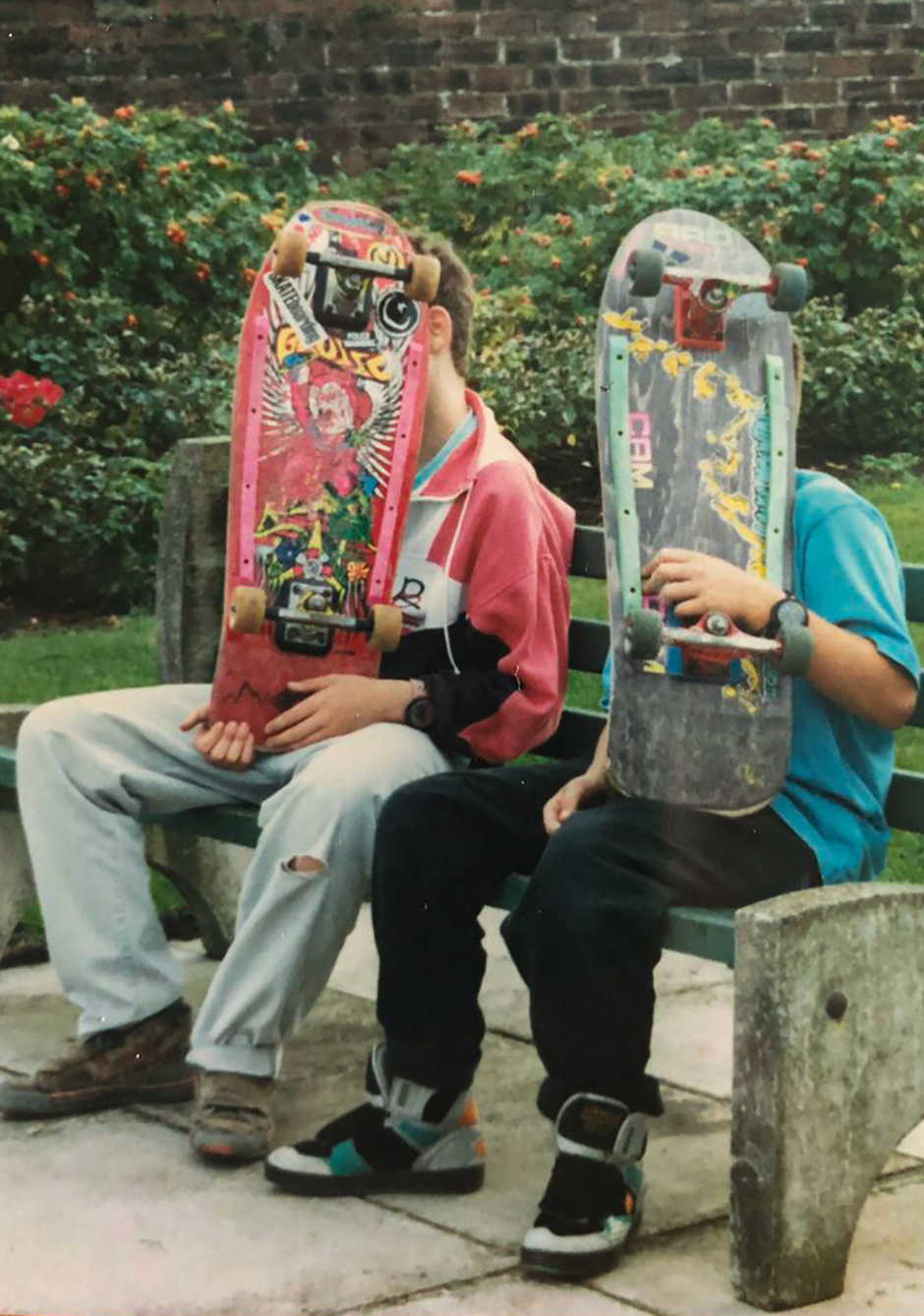
Neil with his lucero Grosso in 1989 when Pop Swatches and Airwalks were order of the day. Notable mention to the TWS sticker in his wheel well
When did you first witness skateboarding, what planted the seed?
The annual family holiday used to be to a hotel in Peebles—which was about an hour away in the car—and in the evenings I got sent to whatever little-kid activity was going on there. On the 1988 trip, one night they had a film night, and they must have hired Back to the Future from the local video shop. I spent the rest of the holiday even more desperate to get home than usual, and when I did, some family friend sold me a Variflex poly-prop for a fiver.
What was your first pro board?
After that plastic Variflex, I got a secondhand Sims Eric Nash with some crumbling green wheels and Ventures, a Cell Block and yellow rails. The top graphic was worn through to the wood and the thing felt like it had been buried under the ground or something; it constantly felt wet and it was about twice the weight of what a skateboard should have been back then, which was already a lot. Following that, I got a Vision Gator for Christmas 1988—so I’ve never particularly keen to have a reissue of my first board up on the wall—but my next board was a Lucero Grosso, so things picked top from there.
Do you remember the point when skateboarding became all-encompassing?
I remember trying to make skateboards for my Star Wars figures, when I still had the plastic Variflex. I think that was the moment when I stopped feeling like a kid playing with toys and only cared about skateboarding.
Can you describe how your obsession with skateboarding and skateboarding media relates to how involved, and obsessed you were with music too.
I was so excited by, and impressed with, anything to do with skateboarding. The bigger boys were always really into music, so like any kid hanging around with older people, I got to hear a lot of things early on that I’d definitely have missed otherwise. Skateboarding and music, and the skateboard and music press, were so important. They were the windows to other worlds, beyond a boring Scottish seaside town where it always seemed to be raining. Meany’s reviews and interviews in Skateboard! definitely introduced me—and a lot of other kids—to music we wouldn’t otherwise have discovered for years.
“Skateboarding and music, and the skateboard and music press, were so important. They were the windows to other worlds, beyond a boring Scottish seaside town where it always seemed to be raining”
Music in skate videos had an impact on everybody then too, because when you’re watching something you love a hundred times the music is definitely going to sink in. The SST stuff in Streets on Fire, McRad in Public Domain and the music in Mouse Is Pulling The Key all stood out. I remember recording the music from skate videos off the TV with a microphone, and listening to that on my paper round, with doors slamming and the phone ringing in the background.
When did you first leaf through a skateboard magazine? What was it? What stood out?
The first mag I got was the first issue of Skate Action, which was only a quid and had a free sticker but didn’t seem very… Coherent. It was quite hard to figure out what was going on and what they were talking about. My second mag was the October 1988 issue of Skateboard!, with the Pig City article and the weird night-vision effect on the cover. It had a free sticker too. The only street thing in that mag was a sequence of a fakie ollie to axle pivot on a kerb, and that definitely felt like the coolest, most modern thing in there, amongst so much vert coverage.

Neil’s first mags. Skate Action Issue 1-September 1988, Skateboard!-October 1988, R.A.D-October 1988
The first issue of RaD I got was just after Skateboard!, and it had way cooler photos, and also a free sticker. There was still lots of vert but it felt much more real, more relatable, and the writing seemed to be aimed at people like me too. Pretty much everybody in that magazine looked really cool, and there’s a photo of a ramp in Tayvallich in the Where? guide that was much more like the sorts of things you’d see around, compared to the perfect ramps in other photos. There were a few things that made RaD stand out as the best of the three, even when these were the first skateboard magazines I’d seen.
What other magazines were part of your consciousness already?
Around that same time I started skating I’d got a paper round, and the part of the shop where I’d make my papers up was where the music magazines were, which meant a constant supply of NME, Melody Maker and Select, and then very quickly i-D and The Face, a magazine called Sky and the excellent Rage magazine, which was published by the same people who did RaD at the time. The skateboard magazines were up near the counter so I’d always have to pay for those, but the music and style mags were there for the taking. Which I did, because I didn’t really know how retail worked or that I was costing the shop rather than the publication money.
I didn’t always understand what was going on inside i-D or The Face, but the photos were cool, the people in them looked good, they had Stüssy ads and they introduced me to people like Corinne Day, Juergen Teller, the Wild Bunch, Acupuncture, American Classics, Laurence Corner and Passenger, as well as music that was different to what John Peel was playing or what the music press was covering.
What writers and photographers had already made a dent in your psyche?
Tim Leighton-Boyce and Gavin Hills were the two who always stood out. Tim’s photos and Gavin’s writing in Read and Destroy. Mark Lebon’s photography for The Face and i-D always stood out, and Meany’s photos in Skateboard! made all this amazing skating seem a little bit more closer to home, since the North of England looked more like what I was used to seeing in Scotland. Nick Philip, Dan Adams and Steve Hicks’ design work on RaD, and what Neville Brody was doing at The Face and Terry Jones was doing at i-D, really stood out, and these magazines had a much more coherent, richer, visual language than the music press of the time.
Sheryl Garratt-era The Face was definitely my era of that magazine, and her editorship covered Acid House, Madchester and what turned out to be the tail-end of Postmodernism, through to Britpop, 24-hour TV and the beginnings of home internet. So much changed in six or seven years, and The Face covered it all incredibly well. Sheryl’s a very important person in terms of UK culture, and what The Face and i-D were doing definitely had parallels to skateboarding, whether they were consciously inspired by it or otherwise. James Brown who did loaded said that Phat was a ‘reference’ for loaded. loaded changed so much, and ultimately was the result of the inspiration from what TLB, Gavin Hills, Vernon Adams and those guys did with Phat.
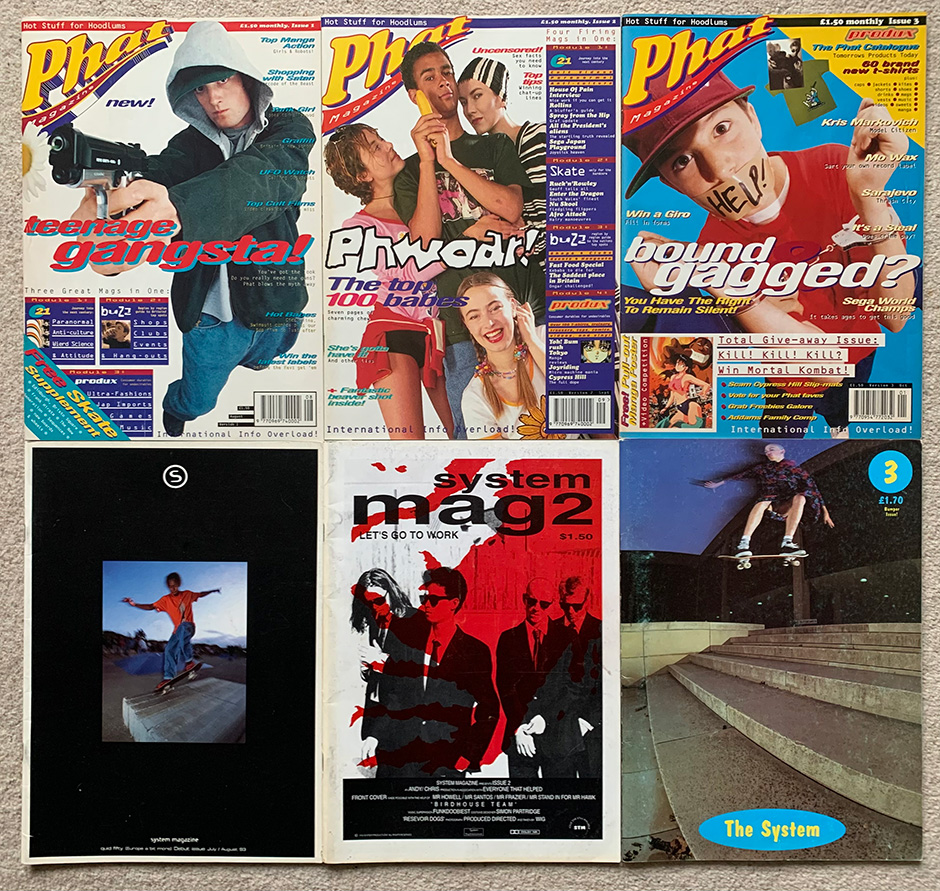
The full run of Phat and the full run of System, from 1993. Both these mags came and went within a year, when the R.A.D title had been sold into the hands of snowboarders. Phat was Tim Leighton-Boyce, Gavin Hills, Vernon Adams and some other former good-era R.A.D people, and System was Andy Horsley, Jonny Robson, Kris Forder and Wig, amongst others, so one mag was like the very end of what the original R.A.D was and the other is the very beginnings of what Sidewalk would be.
Slightly confusingly, those System people ended up doing R.A.D for a while before it ended (post-snowboarders and pre-Sidewalk), while Ben Powell and Johnny Morrow did the budget photocopied STM zine out of Rollersnakes.
Where were you getting magazines from? Did you have subscriptions or reservations?
I eventually started getting RaD and Skateboard! delivered, and I carried on helping myself to the music and style mags. I worked for that paper shop for a long time, and I remember being there when loaded came out, which was 1994, but I think I must have packed it in a bit after that and had to actually start paying for those magazines.
You have mentioned that you religiously bought every UK publication as it came out. When did that start?
Pretty much from 1988, from when I started. I just really liked skateboarding and skateboard magazines.
Are you missing any?
UK-wise, I’m missing maybe half a dozen Documents, from its last couple of years, some later Kingpins, and three issues of the original seventies Skateboard! mag. For US mags I need most of the large-format issues of Thrasher from 1981. I’ve got complete sets of RaD, second-generation Skateboard!, Skate Action, Sidewalk, Transworld, Slap, Big Brother, Warp, second-generation Skateboarder, Homeboy, Poweredge and The Skateboard Mag.
What else did you have going on in the 90s? What kind of job timeline did you have from starting to skate to starting your Insta account?
I did that paper round until I was 17, I think, which is probably a bit longer than most people, but the availability of magazines was too much of a bonus. After that I spent a few years at college failing a design course and then also a multimedia course, took a few years out to sign on, went back to college to fail a music business course, got a job in a record shop for ten years, worked in audio branding for ten years after that, then quit that in 2020 to work on this book.
 When did you first appear in print?
When did you first appear in print?
I sent a review of the local kerb to RaD, for the Where? guide, and it went in. It felt amazing being able to ‘contribute’ to that magazine, and I know and appreciate now how important that was for TLB too, to have the readers involved in the magazine’s content.
How did sending a complaint end up with you writing music stuff for Sidewalk?
In 2007 I sent a rambling, drunken email—which I stand by—to have a pop at their review of the World Industries DVD boxed set, which missed so many important things about those videos. It was meant purely as a complaint, and not meant as a ‘letter’, but it got printed as ‘Letter of the Month’ or whatever, and Ben Powell’s reply was basically, ‘Yeah? Well you do it then’, and I got given the job of reviewing DVDs. Then I answered the letters, and then I started interviewing skateboarders about music, before going on to interviewing bands about music. It definitely wasn’t something I set out to try to do, but massive thanks to Ben because it was lots of fun and the pay certainly helped keep the lights on back then. I was in Australia when the mag came out and Ben got a copy sent over, and a pair of triple-blue DC Lynx sent to my work for when I came back too.
“My favourite, which is probably also the best, was Ian MacKaye. He just answered everything so well and in such incredible depth, and he barely paused for breath”
Which have been the best and worst of those music interviews?
My favourite, which is probably also the best, was Ian MacKaye. He just answered everything so well and in such incredible depth, and he barely paused for breath. He was great. It ended up going across two issues because there was so much. J. Mascis was good once he got going, and Roedelius from Cluster spoke to me for about two hours the day before his 77th birthday and was a great laugh. The worst was GZA, but then Ghostface was a definite highlight.
Did other writing gigs begin and develop from there?
I wrote for The Quietus for a while back then, doing stuff that maybe wouldn’t be a good fit for Sidewalk. I wrote about The Fall for them, and interviewed Steve Albini, amongst other things that I can’t really remember now. I had to write about music psychology for my old job, which was very predictable and boring, but I’ve done things for North, Free, Grey, Dogpiss, The Skateboarder’s Companion, Jenkem and here, for Slam.
Was there a specific point you remember where you made a conscious decision to start archiving stuff digitally?
When my parents died I was clearing out their house, and when I put the magazines I’d bought pre-moving out together with the magazines I’d bought post-moving out it was a pretty complete set of mags, and obviously there’s so much good stuff in them that I didn’t want to just keep them hidden away. One of the first things I scanned and posted was the Simon Evans interview from RaD, November 1992, because people who read that at the time always want to read it again, and people who didn’t see it, should.
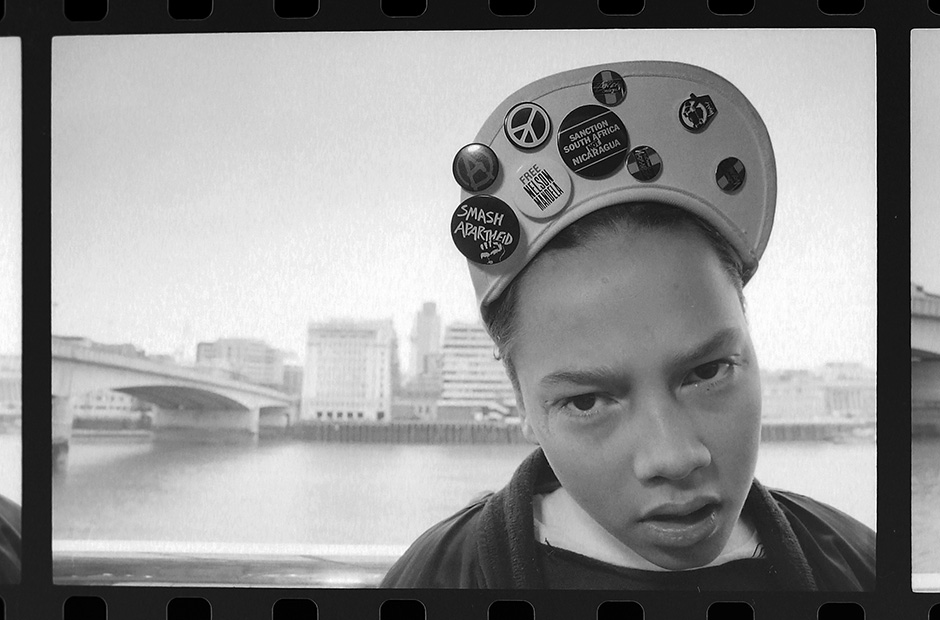
Curtis McCann on the south bank of the river over 30 years ago. PH: Peter Tarry (@ptarry)
Did you agonise about naming the account? The Buck 65 lyric has served you well.
I don’t think so, I can’t remember thinking about any alternative, so it probably just seemed fine. ‘That’ll do, it’s words and it hasn’t been used, perfect’. It’s as complicated as you want it to be, I guess. That line’s from 15 Minutes To Live, which was only ever a b-side. I really loved the early Anticon stuff he put out, and then this track went in the credits of the third Viewfinder video. Ben Powell chose it for that video, and it felt appropriate to have something related to him since he gave me that job at Sidewalk, and it’s a really great tune. It’s a list-tune, and a lot of it has been really relatable over the years. It’s got the line, “I’m not a pack rat, I’m an archivist”, which I like too.
Was there a point with the Tumblr account where you knew you couldn’t stop? Where there was momentum and you first felt some kind of positive affirmation?
Not so much! I’d never used Tumblr before, and it didn’t seem very ‘social’. It was good to see people re-Tumbling posts, or whatever it’s called, but it’s not like people were commenting to chat about the photo, or the photographer, or that issue of the magazine or anything like that. I don’t think Tumblr is really the place for having actual conversations about skateboard photos.
You joined Instagram in 2016. Were you sold pretty quickly on how well it worked for what you wanted to do?
Yeah, Instagram is much more suited to this. When people know who each other are, it’s much easier to have the conversation. Like somebody on their first day on Instagram, with no followers, can still have a conversation with Muska or Michael Burnett or Dave Swift, they can still ask their question and get an answer. Other platforms don’t seem to allow for that interaction so much. Despite the changes to the way it works that we’ve seen over the years, Instagram still feels really social and you can generally find who you’re looking for easily enough.
Obviously it’s not a screenshot account so unless the photo is one a photographer has sent me, it’s a scan from a magazine, which means people will DM and tell me they were in that same issue, and ask if I can send them the photo of them. That’s definitely never a problem, and easier to help with than when it’s a, ‘I was in some magazine in the 90s doing some kind of flip trick, can you find that?’, request.
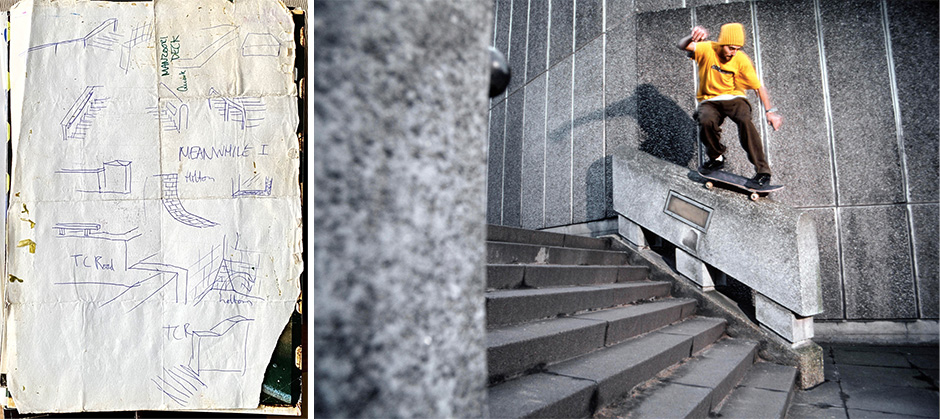
Mike Manzoori backside 50-50s above the roof of UK skateboarding’s spiritual home in 1998. Drawings to the left of the photo are Mike’s biro renderings of potential skate photos. Spy the brutalist hubba beneath the green ink. You will also see his drawing of Tottenham Court Road in the bottom left, a long-gone flatbar he 5-0’d. This drawing would become another Wig Worland photo which ran as a double-page in TWS. PH: Wig Worland (@wigworland)
The DM feature and commenting opened up the floodgates and have led to so many more things. Like a Tony Hawk interview for instance.
Tony’s a good example. He already followed me anyway, but I thought how cool it’d be if I sent him a message and he read it. There are definitely people who just don’t read messages, but I thought he might, so I DMed him a one-liner asking if he’d be up for doing an interview, and how I’d understand if it wasn’t that simple. I mean, he’s going to have agents for that sort of thing, he’s going to employ people to make his appointments with the press and make sure he doesn’t waste his time or speak to the wrong people, probably. But then he got back the next day to say yes, he would be down for an interview, and he asked how I’d like to do it. So a couple of weeks later we spoke for about two hours over Skype, and it was so chill. He’s just so down to talk about skateboarding, and it didn’t feel like he’s this global superstar in the slightest. He’s a really good laugh, just so… Normal. It took a while for the interview to go out, and things had happened for Tony since then, so we ended up doing another hour or so to get it up to date.
What’s the most heartwarming result of one of your posts?
I don’t think I can narrow it down, but I’ve posted pictures of Pepe Martinez and Gabriel Rodriguez that their families hadn’t seen, so that was pretty heartwarming. It’s always good when somebody sees a photo of themselves they either haven’t seen before or haven’t seen for thirty years, or if it’s an uncredited photo and the person’s mates all appear and start tagging him, and it’s some football dad who hasn’t skated since 1992 or something. I’ve had a few messages from people saying how stoked they were to be able to show their kids how cool they used to be.
How many scanners have you ploughed through?
Still using the same one! I’ve got a Canon scanner, and bits have fallen off it from it getting knocked over the years, but it still works fine. The lid broke off, but that’s good for when I need to scan a large format mag anyway. It’s pretty basic so there isn’t much to go wrong, I guess.
Many of the images you post involve editing out captions and outdated design you feel maybe detracts from the photo itself. Do you think analysing design in this way has given you a more defined vision of what aesthetics appeal to you?
Maybe, now that you mention it. A photograph’s appeal changes over the years too. Like a chill shot or the inside of a shop isn’t very exciting when it’s from last year, but after thirty years, there’s so much value to those shots, those last frames of a roll of film that needed to be used up after you’d taken the skate shots of your mate. Seeing what people are wearing or what boards are on the wall and what shoes are on the racks. Seeing the models of cars in the street, or high street shops that are long gone, the everyday things that didn’t matter at the time but are so much more significant now.
Seeing a photograph outside the layout in which it was originally presented can definitely alter the context. I’ve got the Skate Action archive here, and that magazine wasn’t very well designed and it was printed on shitty paper, so it didn’t look great, but seeing the slides and the negs of those shots really changes the appeal of them. The amount of great stuff that didn’t go in that magazine too, that probably should have, is staggering. No mags ever had enough space to print even close to what they were being given, but the difference between what ran and what didn’t in Skate Action is crazy. There are shots that never ran that should have been covers.
“Seeing the models of cars in the street, or high street shops that are long gone, the everyday things that didn’t matter at the time but are so much more significant now”
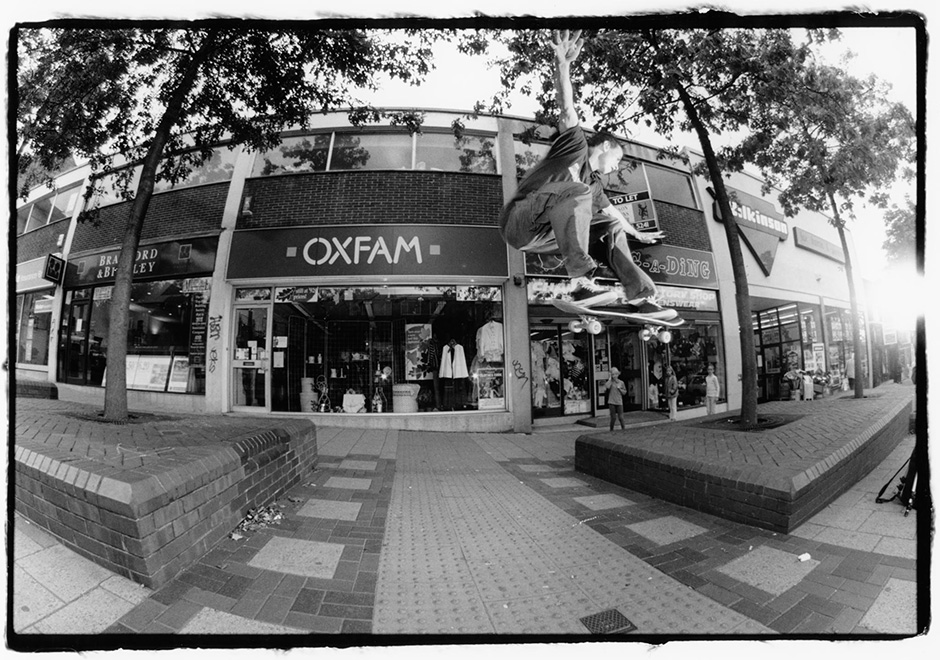
Scott Underdown with a huge ollie in Sneinton, Nottingham, 1997. High Street shop fronts frame the visual. Many of our readers will have never set foot in Bradford & Bingley. PH: WIg Worland (@wigworland)
Did the UK mags make you feel like there was this rad scene out there you could join but you were distanced from or fill you with a sense of inclusion and belonging?
They definitely made everything relatable, and the late-eighties, early-nineties US mags made the stuff they covered seem quite out of reach, except for when there was an East Coast article. Or a UK article, obviously. Everybody in the US mags generally had very new-looking set-ups, and would tend to wear full skate clothes, whereas in the UK mags there were well-worn boards and plenty of non-skate clobber. Basically most of the people photographed for American magazines were sponsored, and there were plenty of people in the UK mags who were not, but you didn’t need to understand that at the time to appreciate that the people in the UK mags seemed more ‘real’. Woolworths resoles, Shoe Goo, re-drilled boards and C&A clothes were relatable to anybody in the UK in ways that box-fresh Airwalks, diagonal ply on ramps and constant sunshine were not.
“Woolworths resoles, Shoe Goo, re-drilled boards and C&A clothes were relatable to anybody in the UK in ways that box-fresh Airwalks, diagonal ply on ramps and constant sunshine were not”
Have you got a good story born from filling in the gaps in your collection?
During lockdown Patrick White, from Southrop, offered me his latter-year Transworld collection. I was missing a lot of those, from the time when Glasgow didn’t have a Borders bookshop or skate shop that sold magazines. We met up at Forton Services—the Lancaster service station with the Brutalist tower—and sat in carpark in the sun for an afternoon talking about skateboarding, and about the RaD coverage of ‘The Southrop Affair’, a contest report by Simon Evans that I’m pretty sure anybody who read it will remember.
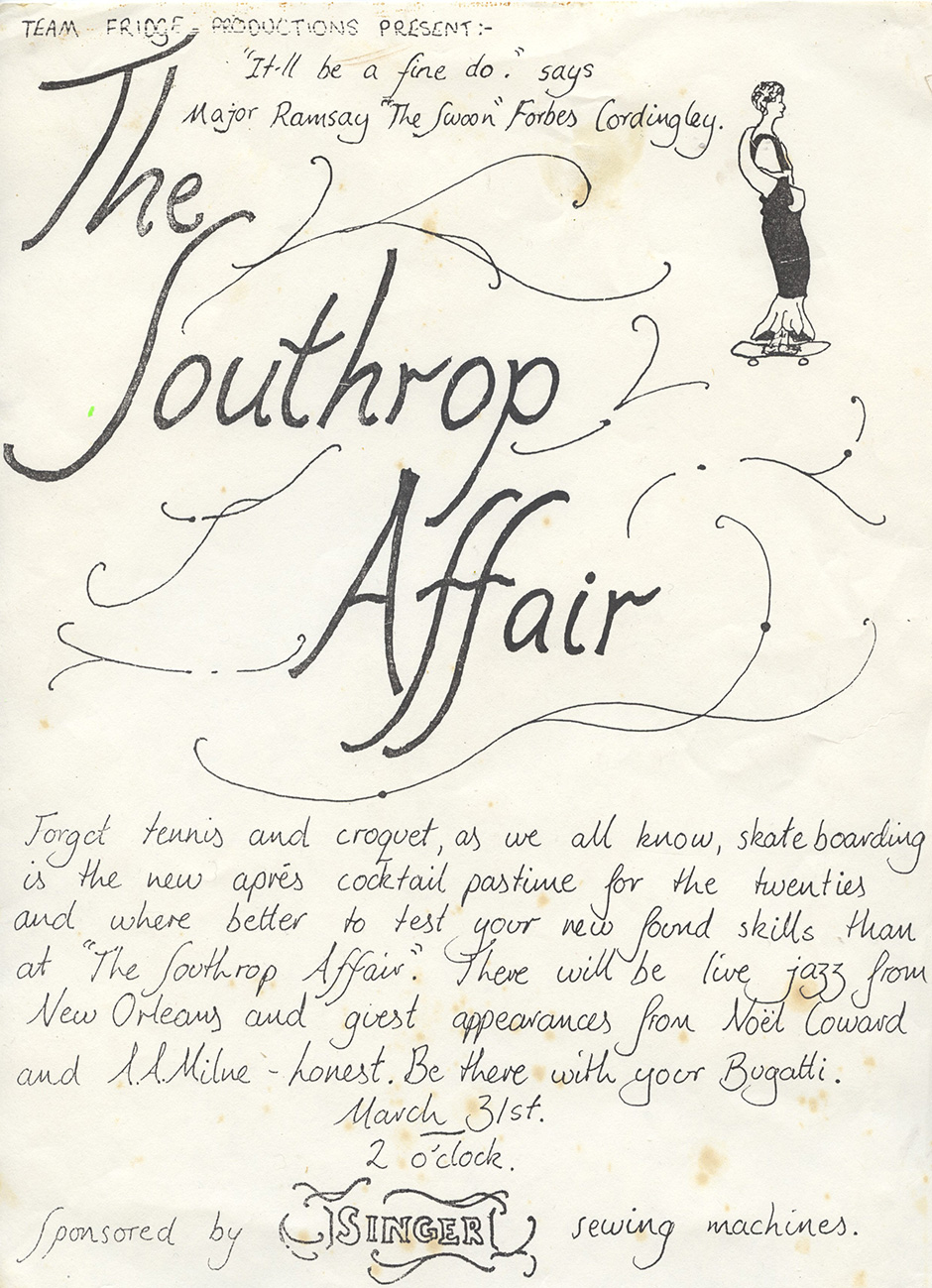
The ‘Southrop Affair’ was a 1920s-themed skate comp in a barn organised for James Davis’ 18th birthday and covered by TLB. Poster design and concept by James Davis (@teamfridge)
Kevin Marks at @lookbacklibrary has definitely been the biggest help in terms of filling the older US gaps, and Ray Calthorpe helped a lot with some early 2000s US stuff I missed because I’d moved out and was spending all my money on booze. Dan Turner hooked me up with some issues of Lodown that I needed, and @yug4924 sent me some mags too, so big thanks to both of them.
What was the first interview you did with a skateboarder?
I asked Colin Kennedy about the music he liked for Sidewalk, when the mag asked me to do some music stuff in 2007. Colin’s always been into good music—and is the only Blueprint rider who would insist on picking his own music—he’s good at talking and I had his number. Second person was John Rattray, for similar reasons.
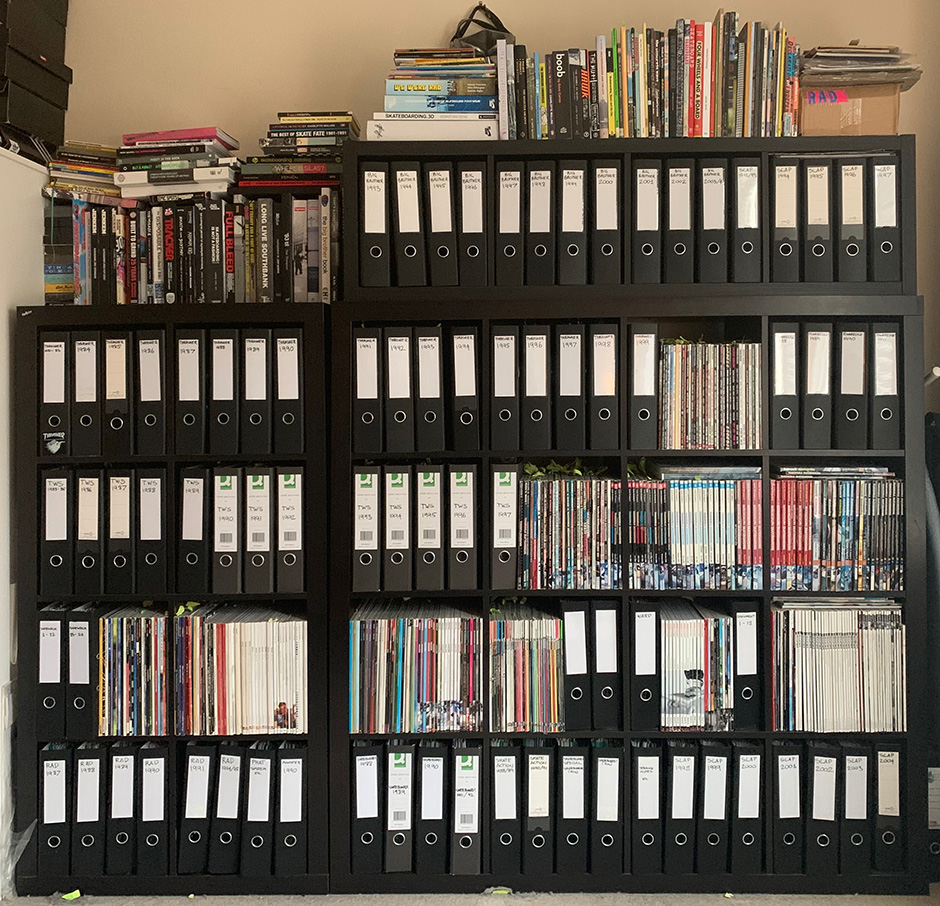
The shelves filled with Neil’s extensive archive of skateboarding media. Shown here is everything up to 2004
It seems all of the interviews you did for Slam transpired organically through the Insta community you built.
I think they probably did… Nobody I’ve asked to do an interview has declined, so maybe I’m just incredibly lucky too. Carl Shipman’s never really used Instagram—it was his wife Katrina who used his account—so I had to message her asking if Carl would be up for talking. She just sent his number so I called him up and we arranged a time to get a proper interview down. I’d been speaking to Eli Gesner a lot around the time of his anyway, so it felt like we could just turn that ongoing conversation into an interview. Steve Kane’s only on Facebook and I’m not, so I had to ask someone to ask, but he’s definitely happy to speak his mind so that wasn’t hard. Most of the time the people already follow the account so they’ll see the message, which helps.

Instagram in an art gallery! The Science Versus Life account on the wall next to Wig Worland at the no comply show in Somerset House
Can you pinpoint a moment where you reframed your perspective on what you were doing and embraced your role as an archivist?
I wasn’t aware that I had, but now that you mention it… I guess so. Being asked to exhibit at Somerset House, for the No Comply show, probably. I’d been asked to contribute to a couple of shows in the past, but neither felt right or properly ‘formed’. What Tory Turk and Helena Long and everybody else on the gallery side did was amazing, and to be on the wall alongside Wig and in the same space as Tim Leighton-Boyce, Winstan Whitter, Alex Turnbull and everybody else, felt pretty great.
On top of mags what else do your archives comprise of?
Books, VHS videos, stickers, catalogues, flyers, mail-outs… I’ve got about seventy or eighty boards, but I know that’s nothing compared to a what the people who actually collect boards have. The school library books are an interesting thing. Steve Kane, Ben Powell and Andy Horsley have each at points been commissioned to make books to explain skateboarding to kids.
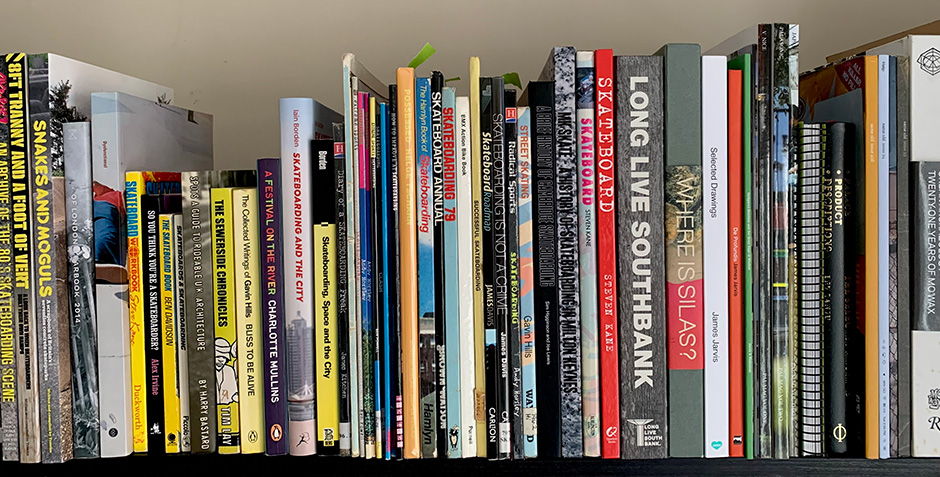
Skateboard books, and these are just the UK publications. Soon Neil’s book Elsewhere will be joining them
This interview is leading up to the next evolution of @scienceversuslife. From the Instagram archiving, to interviews, to a combination of everything with the book you have officially announced. When did the idea for your book germinate?
It came from me wanting this thing to exist, when I was furloughed in 2020. There was only so much that could fit in a monthly magazine, and only so much that could go in a video, but so much more happened. Not just in terms of tricks being landed, but everything else, all the things that happened in the background.
It’s not the book of the Instagram account, but the Instagram account has helped me to do this, because it’s a good way to be in touch with a lot of the people who are contributing to the book. There are a lot of people who were involved in British skateboarding who aren’t on Instagram, but in most cases their mates are, so it’s been easy enough to get in touch with everybody so far.
“I think the original idea is still the objective: a chronological look at skateboarding in the UK between 1987 and 2002, with the story told by the people who were there, and illustrated with photographs nobody’s seen, as well as the classics”
How quickly did you know exactly what you wanted to do?
Straight away I guess, because I wished this existed. It’s not like I’m some businessman trying to figure how to make a book, it seems obvious to me what it should be like, whether that’s right or not. I think the original idea is still the objective: a chronological look at skateboarding in the UK between 1987 and 2002, with the story told by the people who were there, and illustrated with photographs nobody’s seen, as well as the classics. Two-and-a-half years in and the only difference is that I’ve got so much more material than I could have dreamed of. So much went on beyond the stuff that was in the magazines, and a lot of memories are being jogged right now. Quite often somebody will tell me to ask so-and-so about such-and-such a thing, and they’ll have completely forgotten about but it all comes back when it’s mentioned.

Preliminary sketches for the Blueprint ‘investigation’ series by James Bridson courtesy of Dan Magee. A good example of how much digging in the crates people have been willing to do for Elsewhere already
Do you have backing and who will be printing it?
I’m beyond stoked to have the backing of New Balance, and have it published through Palomino. Massive thanks to Mackey, Seb, Baines and Nick.
What’s it going to be called and why?
It’s called Elsewhere. I wanted Dan Magee to name it, since he’s played such an important role in the creative progression of UK skateboarding, and that was one of his suggestions. The name needed to be straightforward without being too basic, clever without being too complicated, original, and look good on stickers. I like how that word suggests ‘not America’, in terms of the public’s broader understanding of skateboarding and its geography, but within skateboarding and in this context it hopefully suggests all the places and scenes outwith the big cities or obvious spots. It’s where skateboarding existed during most of the book’s timeline too, kind of on the periphery of culture, although that does change in the later years, obviously. And it’s where security guards tell you to go.
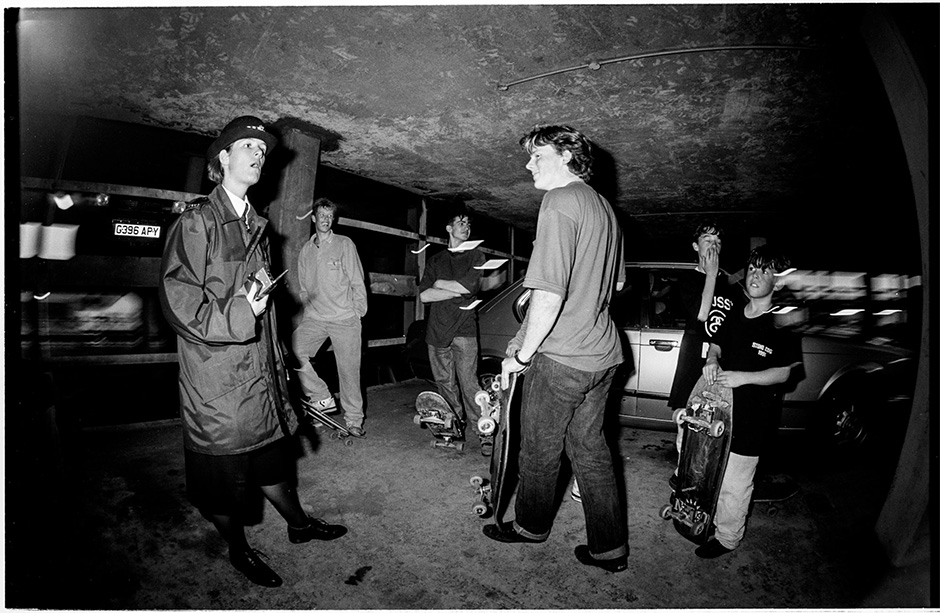
Kicked out. Being Told to go Elsewhere by a carpark security guard. PH: James Hudson (@jamesahudson)
How far-reaching are the interviews you have already completed and lined up?
It goes deep, because the story of skateboarding in the UK isn’t just about the people who were in the magazines and videos. The people who bought the magazines and videos, and the boards and wheels and clothes, meant those things could exist, and the people going to skateparks and contests meant those things could exist. I’m not just talking to the ‘main’ people, because the customers of the shops and the people going to the comps have got as much to say about what went on as the dude on the cover of a magazine does, so there are people that I’ve got a few words from about something that happened one day, and then there are people like Ben Powell and Dan Magee whose time covered way more, and to whom I’m constantly speaking. Skateboarding meant as much to some kid skating a brick in a village in the middle of nowhere by himself as it did to somebody who had the best spots on their doorstep and who got all their stuff for free. The enthusiasm in the little towns and villages was just as important in what was happening in the cities.
“Skateboarding meant as much to some kid skating a brick in a village in the middle of nowhere by himself as it did to somebody who had the best spots on their doorstep and who got all their stuff for free”
There’s Sheryl Garratt and Miranda Sawyer talking about Gavin Hills there too, and shop people who sold skate stuff but didn’t actually skate, so it’s not like everybody in the book was a skateboarder. Although the vast majority were, or they were filming or photographing it.
There’s a selection of choice quotes from interviews at www.scienceversuslife.com and you can join the mailing list there too.
Do you have a kind of murder investigation wall with pieces of string, mugshots, and musings?
Lots of piles of stuff. Lots of spreadsheets.
How will you tie all of these stories together?
Everything relates to everything else one way or another, if you go deep enough, but the book will be chronological. I’m putting it together vaguely geographically, because that feels like the most logical way to gather information and do interviews, when I can go heavily into a scene over the years, then spread those bits around date-wise.

Ben Wheeler tweaks a melancholy at southbank, some early graffiti removal plays background to his ascent. PH: Corin Casey (@mistaken_id). Corin and his brother Simon are responsible for documenting what was happening at Souhbank in the early 90s. Watch The Southbank Video from 1991
So this is a full-time job in itself.
I’m doing this full-time, yeah. I quit my job in 2020 to work on this instead. It’d take the rest of my life it was only evenings and weekends, and I need to be available at strange times, sometimes, because not everybody involved in UK skating still lives in the UK, so there are calls to Australia, New Zealand and the US being done. If somebody suddenly has time for a call, I want to be able to speak to them and not have to schedule it for in two weeks or something.
Your library of scans make up a wealth of images you could employ but do you have other contributors for this?
It won’t be too heavy on the scans, there should really only be scans of skate photos if the original has been lost, and there’s so much stuff out there that’s never been seen that there’s no real need to run scans of things that have already been in print. Wig Worland’s archive, for instance, is incredible. Everything’s in order, and there is just so much amazing stuff there that has never seen the light of day. It’s so much fun going through all his folders.
Most photographers have still got a lot of stuff that’s never been seen, and photos that show what a day out skating actually looks like—and not just the perfect pro shots of amazing tricks—are just as important. The photos taken on a point-and-shoot and processed at Boots can be just as important as a pro shot.
“The photos taken on a point-and-shoot and processed at Boots can be just as important as a pro shot”
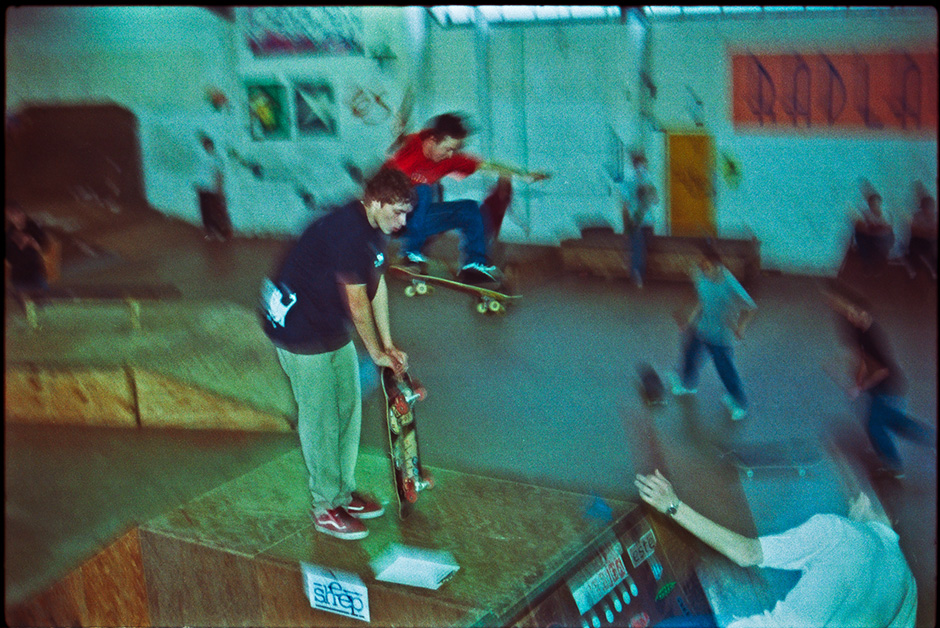
Dan Cates waits while Howard Cooke ollies. Chaotic Radlands photo from 1995, possibly processed at Boots. PH: Jono Atkinson (@jonozero1)
When you’re trying to shoot skating, and you need to use up the last couple of frames so you shoot your mates sitting smoking a cig or eating a sandwich… Those are the important shots now. If you’ve got a box of photos stuffed away in the attic behind the Christmas tree or something, give me a shout!
It’s been good going through newspaper archives too; it’s interesting seeing the stories go from ‘Skate-board fad returns!’ To ‘Skateboard menaces terrorise town centre’ to ‘Where to get the coolest skate fashion’. The public and the media’s changing perception of skateboarding over the years.
What message do you have to the people you haven’t spoken to yet?
I’ll be in touch! If you’re wondering why I haven’t been in touch, it’s because it’s become very difficult to do this in an ‘order’. Somebody might only be available one day in a month, and they’ll tell me something that means I need to then go and interview somebody else that I wasn’t planning to, and so on. Having to jump about chronologically and geographically to get everything in means I can’t really speak to people in any kind of arranged order.

The evolution of public perception. Clippings clockwise from left: Cambridge Evening News 1987, Birmingham Evening Mail 1996, Western Daily Press 1998
How big is the book going to be?
Somewhere in the region of 400 pages. I feel like it could be twice that, so it’s a case of knowing when to stop and being able to edit.
The book covers 1987 to 2002. Can you explain the significance of this period?
By 1987 the UK had its own modern skateboard identity, and it wasn’t just trying to be a version of Californian skateboarding. It had its own identity before 1987, of course, but 1987 was when Tim Leighton-Boyce took over editorship of BMX Action Bike and turned it into RaD, Death Box appeared, Mud Machine changed into M-Zone, street skating was a real thing, and people no longer had to go to America to ‘make it’. Thrasher and Transworld started running serious UK articles in 1987 too.
Back to the Future came out in UK cinemas in December 1985, and on VHS in December 1986, so throughout 1987 all these people who’d seen it and then dug out a polyprop from the previous generation’s stash were getting their first real complete for the next birthday or Christmas. Bike shops, toy shops and hardware shops were getting accounts with skateboard distributors to supply the new demand, and it feels like a whole generation got their first board in the space of the same eighteen months, whether they’d already been BMXing or not. Then when more skate shops started opening, they were shops aimed at this new generation, and they weren’t sharing space with BMX.
“Skateboarding in the UK had adapted to its climate and the terrain…so people in the UK were having to skate differently to how people in California did anyway”
Skateboarding in the UK had adapted to its climate and the terrain. The concrete parks were mostly crumbling relics of the late-seventies boom, and obviously the streets are rougher, so people in the UK were having to skate differently to how people in California did anyway. I mean, the Ged Wells crack-nollie sequence that blew people away in 1989 could never have happened on smooth Californian pavement. All these differences fed into the media and the companies, and created something quite different to what was happening elsewhere in the world.
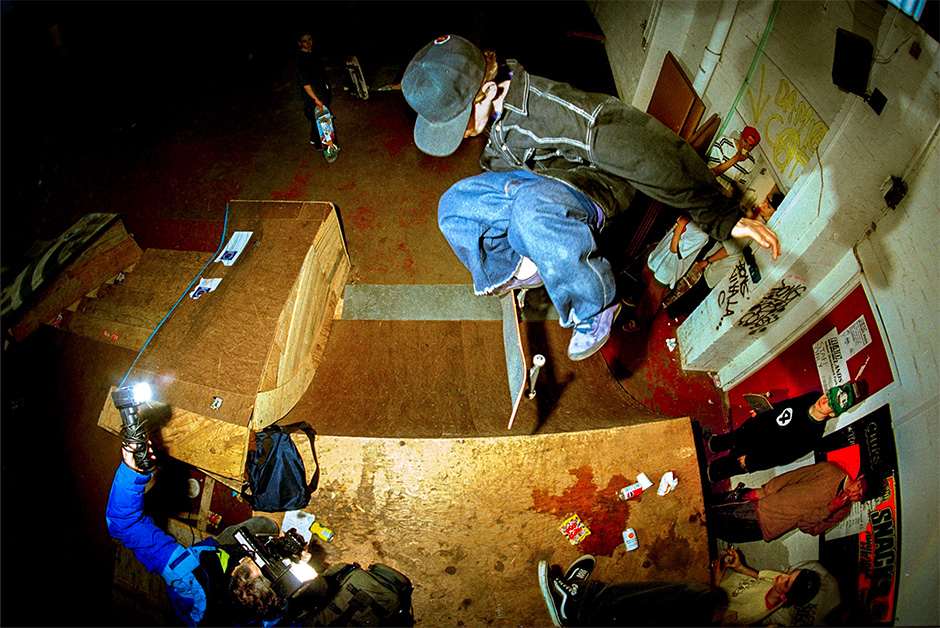
Tom Penny kickflips to fakie at radlands in 1992 just before it was redesigned. peep the Ronnie Bertino Blind Mr. Butts BGP and TLB shooting in the lower left corner PH: James Hudson (@jamesahudson)
Other societal changes shaped skateboarding in the UK too, like the absence of—and subsequent introduction of—Sunday trading, and the rise and fall of out-of-town retail parks, with their kerbs, manual islands and gaps. The decline of industry, especially in the North, during Thatcher’s 1980s and the early-nineties recession led to a lot of empty warehouses which could then be taken over for skateboarding.
“The decline of industry, especially in the North, during Thatcher’s 1980s and the early-nineties recession led to a lot of empty warehouses which could then be taken over for skateboarding”
The book goes up to 2002 because to me, that’s around the time when skateboarding had completed its most important developmental stage, and much of it after then is documented anyway, since digital cameras had become affordable and most people had access to the internet in one way or another by then. Skateboarding had boomed again then too, because of the Tony Hawk’s Pro Skater generation, and all these new people were immediately able to take inspiration from history, from what either Kareem Campbell or Jamie Thomas did, rather than be carried along by the waves of changing trends.
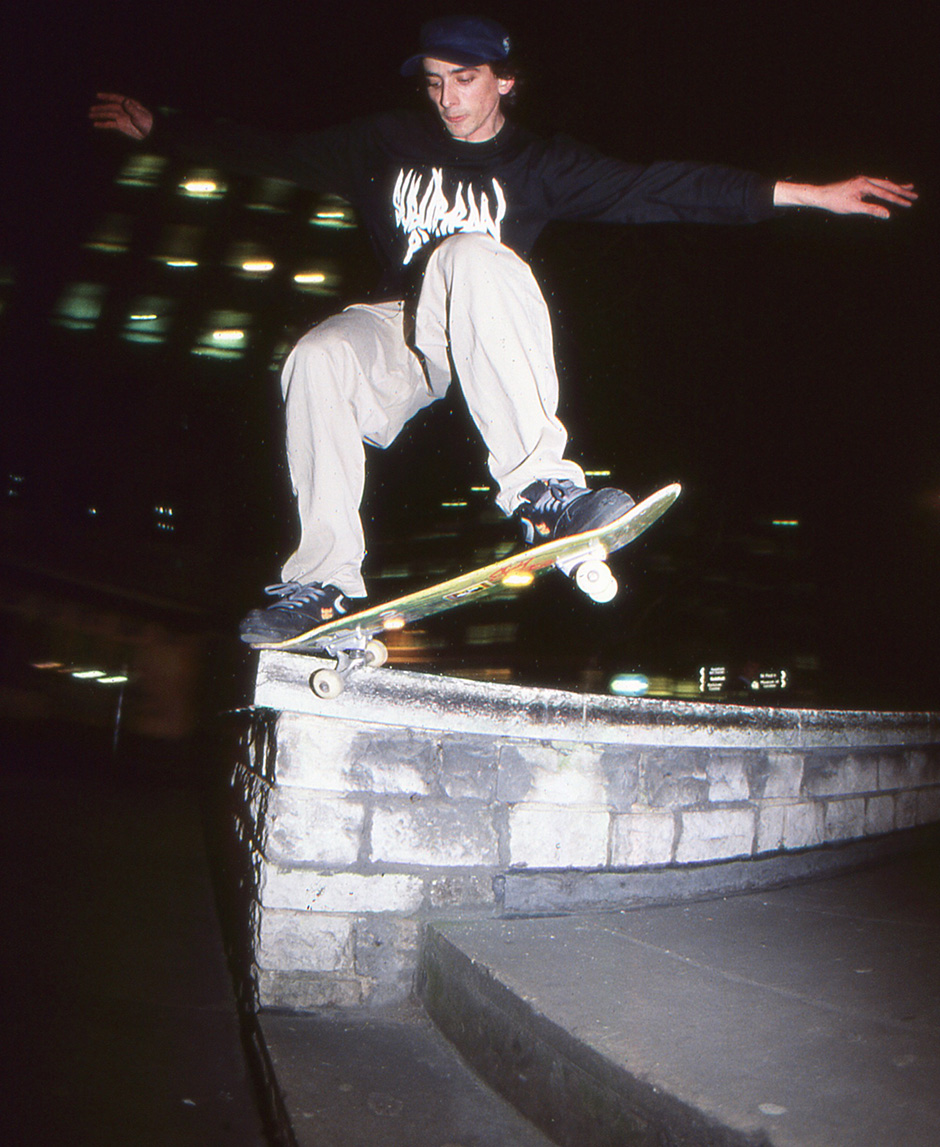
Toby Shuall Switch crooked grinds in 2002. 10 years after Tom’s kickflip above and the last year that will be covered by Elsewhere. PH: Dan Turner (@vitalsound_)
When Francis Fukuyama spoke about ‘the end of history’ he was—broadly speaking—talking about the end of any idealogical competition to democracy, but I think the term applies to post-millennium skateboarding too. By the turn of the 2000s skateboarding had become able to refer to itself, to draw influence from its own past in order to move forwards. It’s not that it isn’t still moving forwards, because obviously you’ve got five year-olds who can do 900s or whatever, and people flipping into waist-high ledge tricks, but in cultural terms I’d argue that everything that came after the beginning of the millennium exists because of something that had happened previously.
“ in cultural terms I’d argue that everything that came after the beginning of the millennium exists because of something that had happened previously”
It’s similar in music, where we were wondering what incredible new and exciting music was going to appear in the 2000s, and then ended up just looking backwards. Things like The Strokes and the White Stripes with garage rock, Daft Punk and disco, and the general obsession with nineties hip-hop. Bands reforming for greatest hits tours and reissuing albums, whether it was Fleetwood Mac or Throbbing Gristle. Obviously plenty of exciting new things still happen in skateboarding and music, but it’s just that the development moves in more sprawling directions rather than so noticeably forwards, and new things can tend to be connected to something previous.
Do you think working on this book has improved your interview technique in any way?
It’s certainly improved my knowledge, so I guess I’m capable of having deeper conversations with people now. I think I’ve started speaking a lot more clearly too, since I’m speaking to people with all sorts of accents on the phone, on Skype or on Zoom, where the line might not always be great, or over a coffee or a pint somewhere noisy.
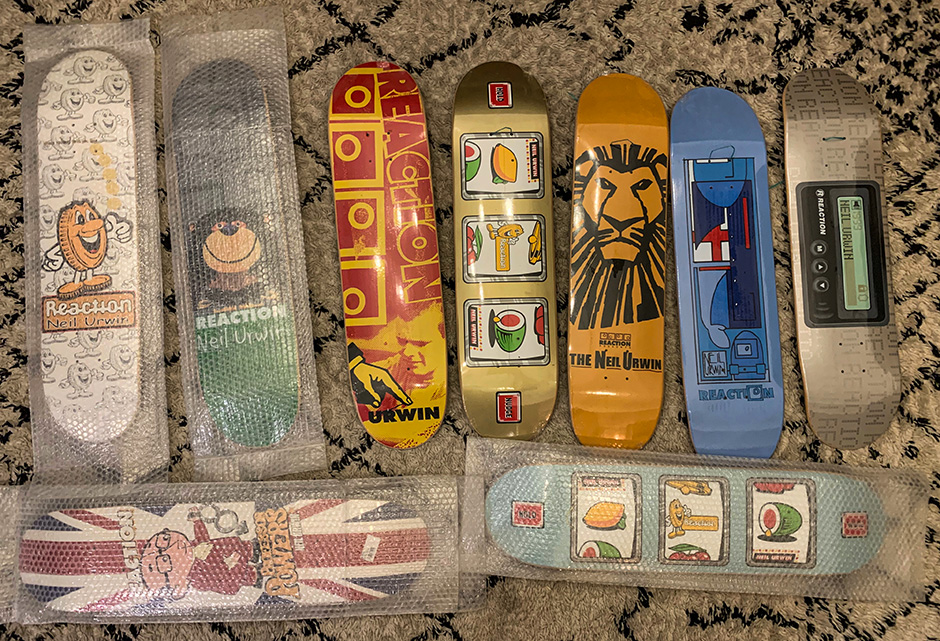
Neil spent some time in the North East of England, doing interviews and speaking to people about the various eras of skateboarding there, the spots and the shops. Neil Urwin is one of the few people who managed to keep one of each of his boards
Through working on this you have interviewed all of the editors of the UK mags which made such an impact on you. Steve Kane, TLB, Ben Powell, Percy Dean. It must have been great to unpack their visions of skateboarding through conversation…
All such important people, doing a fairly thankless task for not very much money. I’m trying to be as thorough as I can with magazine people, and it’s interesting to hear about the different motivations and various hurdles behind getting a magazine out each month across different periods of time. All the publishing politics too, and what could or should have gone in, and the things that maybe shouldn’t have gone in but did.
Do you think there will be some level of catharsis when this comes to fruition or will your brain will simply lead you onto the next thing?
Honestly, fuck knows. All I’m thinking about is making sure this book exists and has as much in it as possible.
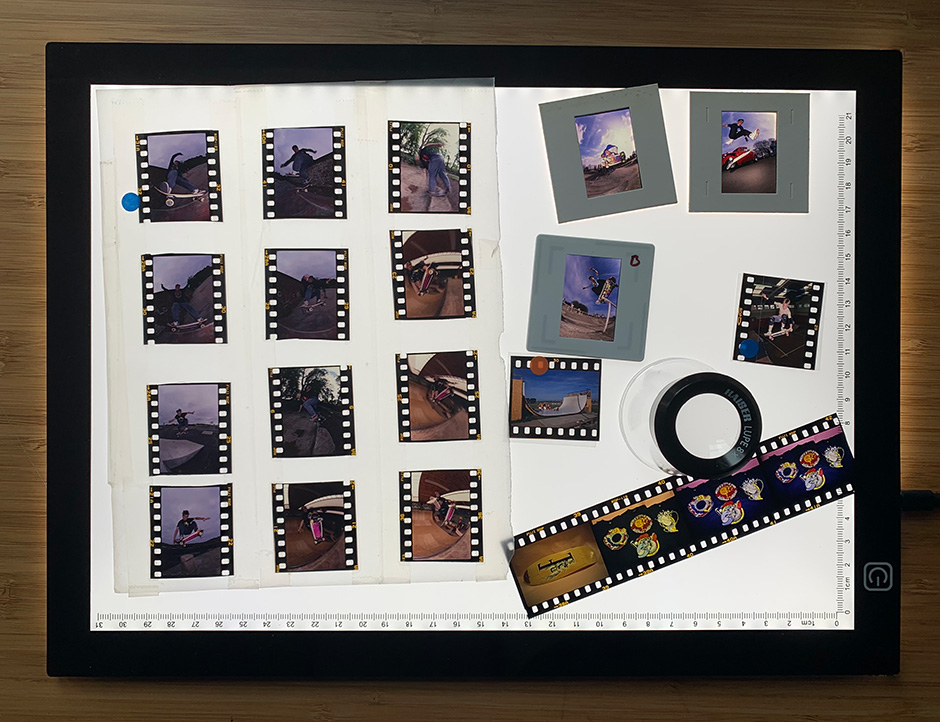
Lightbox work. The selection process at the Elsewhere headquarters
In your opinion what are the best skateboarding books that have been released to date and why?
It depends what you’re looking for, or are in the mood for, doesn’t it? The Southbank and FTC books are both a good balance of photos and writing, although being a snobby elitist wanker, it bothers me how much stuff is missing from each of those. There have been a lot of missed opportunities, skateboard-book wise, I think. Sean Cliver’s first Disposable is probably the book that’s given me the most pleasure over the years.
Anything else?
Yeah, I’d like to say a massive thank you to everybody that’s spoken to me so far, and to everybody who’s dug out photos, whether from their studio or from a shoebox in the attic. Thanks to everybody who skateboarded, shot photos, filmed, ran a company, opened a shop or worked on a magazine, and who kept doing it when all reasonable logic made it seem like a bad idea. Thanks especially to Wig Worland, Ben Powell, Seb Palmer, Dave Mackey, Mark Baines, Nick Sharratt, Dan Adams, Gareth Skewis, Sam Ashley, Jagger, Kevin Parrott, Ryan Gray, Dan Magee, Ray Calthorpe, James Hudson, Kevin Marks, James Jarvis, Jamie Scott, Walker Murdoch and you for doing this interview.
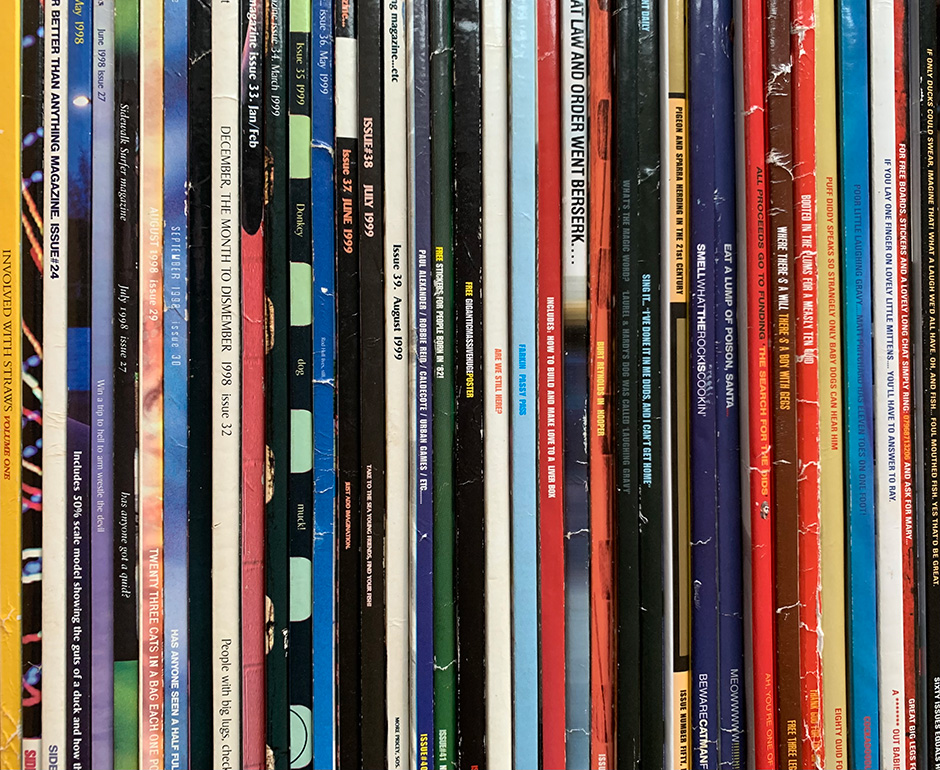
Even the spine of sidewalk was injected with Ben Powell and Andy Horsley‘s humour and creativity. Elsewhere promises to go deep into their story and beyond
We would like to thank Neil Macdonald for taking the time to talk to us. His publication will be an essential addition to any skateboarder’s bookshelf and we can’t wait to see the fruits of his labour. Thanks also to Wig Worland, Ray Calthorpe, Peter Tarry, Dan Magee, James Hudson, Simon and Corin Casey, Dan Turner and Jono Atkinson for their photographic contributions to this interview. This is just a glimpse at the wealth of images which will fill the pages of Elsewhere.
Previous Neil Macdonald interviews for Slam City Skates: Alex Moul, Jeff Pang, Tobin Yelland, Steve Kane, Pete Thompson, Jeremy Elkin, Sam Ashley, Don Brown, Eli Morgan Gesner, Corey Duffel, Carl Shipman, Tony Hawk, Neil Blender

